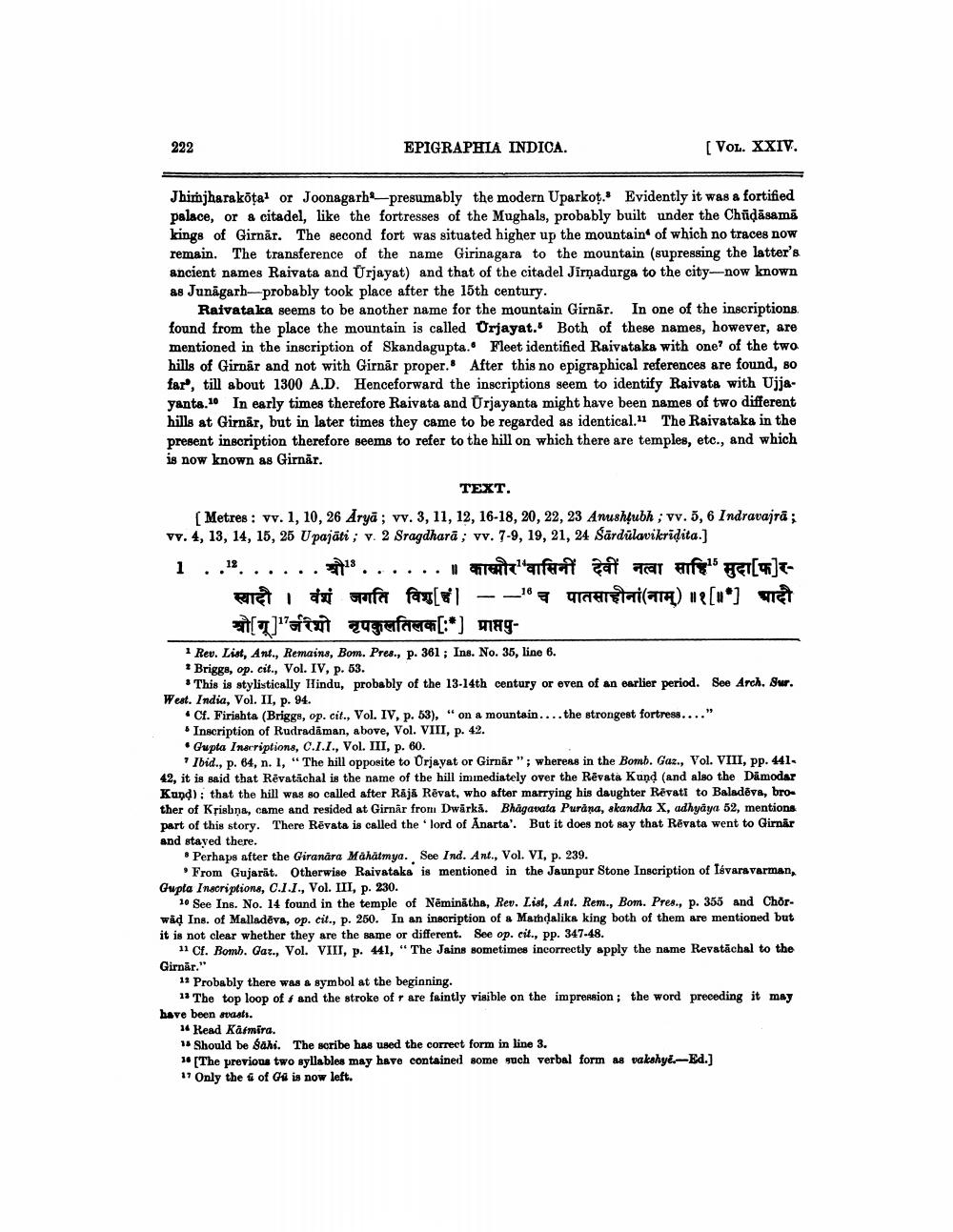________________
222
EPIGRAPHIA INDICA.
[VOL. XXIV.
Jhimjharakõtal or Joonagarh presumably the modern Uparkot. Evidently it was a fortified palace, or a citadel, like the fortresses of the Mughals, probably built under the Chūdāsamā kings of Girnar. The second fort was situated higher up the mountain of which no traces now remain. The transference of the name Girinagara to the mountain (supressing the latter's ancient names Raivata and Urjayat) and that of the citadel Jirnadurga to the city--now known as Junagarh-probably took place after the 15th century.
Raivataka seems to be another name for the mountain Girnar. In one of the inscriptions found from the place the mountain is called Urjayat. Both of these names, however, are mentioned in the inscription of Skandagupta. Fleet identified Raivataka with one of the two hills of Girnar and not with Girnār proper. After this no epigraphical references are found, 80 far, till about 1300 A.D. Henceforward the inscriptions seem to identify Raivata with Ujjayanta.10 In early times therefore Raivata and Urjayanta might have been names of two different hills at Girnar, but in later times they came to be regarded as identical." The Raivataka in the present inscription therefore seems to refer to the hill on which there are temples, etc., and which is now known as Girnar.
TEXT.
Metres : vv. 1, 10, 26 Aryā; vv. 3, 11, 12, 16-18, 20, 22, 23 Anushļubh ; vv. 5, 6 Indravajrā; vy. 4, 13, 14, 15, 25 U pajati; v. 2 Sragdharā; vv. 7-9, 19, 21, 24 Sārdülavikridita.) 1 ........ 118 ... ... ! TEATafat a tear Hifi HET[6]T
PICTI & pfat fan[- _18 YIGHETTI(FTA) 18[w] et
[7] qugrafaat[:*) magRev. List, Ant., Remains, Bom. Pres., p. 361; Ins. No. 35, line 6. * Briggs, op. cit., Vol. IV, p. 53.
* This is stylistically Ilindu, probably of the 13-14th century or even of an earlier period. See Arch. Sur. West. India, Vol. II, p. 94.
4 Cf. Firishta (Briggs, op. cit., Vol. IV. p. 63), "on a mountain.... the strongest fortress...."
Inscription of Rudradāman, above, Vol. VIII, p. 42. Gupta Inscriptions, C.1.1., Vol. III, p. 60.
* Ibid., p. 64, n. 1, "The hill opposite to Orjayat or Girnär"; whereas in the Bomb. Gaz., Vol. VIII, pp. 441. 42, it is said that Revatachal is the name of the hill iminediately over the Rēvata Kund (and also the Damodar Kund): that the hill was so called after Raja Rēvat, who after marrying his daughter Revati to Baladēva, bro ther of Krishna, came and resided at Girnar from Dwarka. Bhagavata Purana, skandha X, adhyaya 52, mentions part of this story. There Rēvata is called the lord of Anarta'. But it does not say that Révata went to Girnar and stayed there.
. Perhaps after the Giranära Mahatmya. See Ind. Ant., Vol. VI, p. 239.
From Gujarät. Otherwise Raivataks is mentioned in the Jaunpur Stone Inscription of Isvara varman, Gupta Inscriptions, C.1.1., Vol. III, p. 230.
16 See Ins. No. 14 found in the temple of Nēminátha, Rev. List, Ant. Rem., Bom. Pres., p. 355 and Chor. wad Ins. of Malladeva, op. cit., p. 250. In an inscription of a Mardaliks king both of them are mentioned but it is not clear whether they are the same or different. See op. cit., pp. 347-48.
11 Cf. Bomb. Gar., Vol. VIII, p. 441, " The Jains sometimes incorrectly apply the name Revatāchal to the Girnar."
12 Probably there was a symbol at the beginning.
11 The top loop of 6 and the stroke of r are faintly visible on the impression; the word preceding it may have been evaats.
Read Kasmira. 1. Should be sami. The scribe has used the correct form in line 3. 10 The previous two syllables may have contained some wuch verbal form as vakahyl.-Ed.] 17 Only the 4 of Ge is now left.




